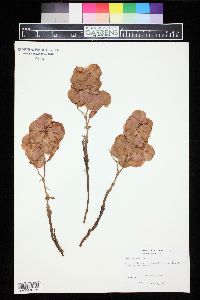|
|
|
|
Family: Polygonaceae
veiny dock
|
Plants perennial, glabrous or nearly so, with creeping rhizomes. Stems ascending or, rarely, erect, usually producing axillary shoots near base, (10-)15-30(-40) cm. Leaf blades ovate-elliptic, ob-ovate-elliptic, or ovate-lanceolate, (2-)4-12(-15) × 1-5(-6) cm, subcoriaceous, base narrowly to broadly cuneate, margins entire, flat or slightly undulate, apex acute or acuminate. Inflorescences terminal and axillary, usually occupying distal 2/ 3 of stem/shoot, usually dense, or interrupted in proximal part, broadly paniculate. Pedicels articulated near middle, filiform or slightly thickened, (8-)10-16 mm, articulation distinct, slightly swollen. Flowers 5-15 in whorls; inner tepals distinctly double-reticulately veined, orbiculate or reniform-orbiculate, 13-18(-20) × (20-)23-30 mm, base deeply emarginate or cordate, margins entire, apex rounded, obtuse, rarely subacute, with short, broadly triangular tip; tubercles absent, occasionally very small. Achenes brown or dark brown, 5-7 × 4-6 mm. 2n = 40. Flowering spring-early summer. Sand dunes, sandy and gravelly riverbanks and slopes, deserts, grasslands 200-1500 m; Alta., Man., Sask.; Ariz., Calif., Colo., Idaho, Iowa, Kans., Minn., Mont., Nebr., Nev., N.Mex., N.Dak., Okla., Oreg., S.Dak., Tex., Utah, Wash., Wis., Wyo. Rumex venosus is a distinctive species rarely confused with any other members of the genus. However, I have seen herbarium specimens of it misidentified as R. hymenosepalus, and vice versa.
Glabrous, rhizomatous perennial 2-6 dm; lvs ovate to oblong or lanceolate, flat, entire, 4-12 cm; infl very dense in fr; pedicels weakly jointed near midlength; valves rose-color, 1.5-2 נ2-3 cm, without grains; 2n=40. Dry soil in waste places; native of w. U.S., rarely adventive in our area. Gleason, Henry A. & Cronquist, Arthur J. 1991. Manual of vascular plants of northeastern United States and adjacent Canada. lxxv + 910 pp. ©The New York Botanical Garden. All rights reserved. Used by permission. |


